Cities: Skylines: 10 Interesting Facts About This Awesome City-Building Game

Being The Mayor Of A Fast Growing Metropolis Has Never Been This Engaging
The city builder genre has been running really dry these last few years. The latest installment of Sim City ended up being a huge disappointment for many, and Cities in Motion were unable to scratch that itch for a real city-building game. People have been playing Banished over and over again, but as awesome as Banished can be, it's still not Sim City.
This is why the announcement of Cities: Skylines was such a big hit. It was like a bomb being dropped on EA's franchise. Cities: Skylines truly is a jewel of the genre, and while it's still not the embodiment of perfection, it's far closer to it than Sim City could ever hope to be.
You know when a game is amazing when a single word is enough to convince you. Do you want to know what that word is?
Paradox Interactive. Okay, I lied. That's two words.
1. It's Been A While Since We've Last Had A Good City Builder
Look at this! Isn't it promising?
And by “good city builder” we don't mean a half-done game with dumbed down features that requires the player to be constantly connected to the Internet. We all know what we're talking about here. That was a hard pill to swallow, and it's good to see a new title from a different developer to pick the genre up where the last good Sim Cities left it at, and improve upon it.
In Cities: Skylines, you take on the role of a mayor given the task to build a city from the ground up. Whether your future creation turns out to be a grim industrial complex or a beautiful coastal city where life is good and the sun always shines bright, you will need to manage your finances to avoid going backrupt and do your best to meet the basic needs of your population.
Just like in other city builders, you can achieve that by creating residential, commercial and industrial areas, raising taxes, creating infrastructures (roads, public transportation, electricity) and providing services (health, education, public safety...).
These are the staples of the genre, but Cities: Skylines improves on them to make city-building an even more enjoyable experience.

A sprawling city is a beautiful sight to behold.
2. The Challenge Is Ever-Present

The city has developed a lot, managing it is going to get progressively harder.
Cities: Skylines does not hold the player by the hand. While the bases of a generic city builder are there, allowing for some easy and “quick” (relatively speaking – it *is* a city builder a.k.a. time eater, after all) fun, it is when you want to build something bigger and more long-lasting that the game shows its true colors.
Many of Cities's features are very detailed and complex and take patience and understanding to master. The game features an elaborate supply chain of goods which require specific industries and commerces to manufacture, turn into merchandise and be sold. This is not a game where you can “draw and forget” zones.
The bigger your city becomes, the easier it gets to make mistakes – and on a scale of several hundreds of thousands of citizens, one small mistake can spiral into an economic (or environmental) catastrophe. Meticulous planning is required in order to succeed.
Of coursе, we're not speaking Dark Souls levels of difficulty here, but Cities: Skylines has a certain learning curve, and will keep your neurons engaged for the entire time you'll be playing it.
3. The Level Of Detail Is Astounding

When you zoom in, the city feels alive.
The sheer amount of variety in Cities: Skylines is simply impressive. Each building feels individual and unique and you never know what kind of building will spawn next in a newly-allocated area. The street layout is not always geometrical: the city's infrastructure adapts itself to the terrain, with elevated roads crossing each other when necessary, giving a multilayered, tridimensional feel to the ensemble.
The population is not just a faceless number. Each and every inhabitant is a unique person, with a name, an age and a level of education. You can “bookmark” a specific person and follow them over the course of their life as they grow up, study and look for work.
The citizens provide workforce for the industries and commerces in your city. While it is normal to expect that these facilities will not work without citizens, it is not a simple causal relation such as “If you have enough population, businesses will be running”. Each person brings their own simulated touch to them; if a citizen is overqualified for a job they're currently employed at, they'll even go job hunting!
Pollution is a big factor in how your city fares. Noise pollution will make your population unhappy, while environmental pollution will have a negative impact not only on your citizens' health, but also on the land itself. Fertile lands may become barren, and trees wither and die if pollution exceeds a tolerable level.
There is even water physics simulation. Don't expect to build a dam right in the middle of your city without consequences – the water level will rise and the surrounding area might become your city's favorite fishing spot, if there are any fishing fans left to tell the tale.
4. Extensive Local Traffic Simulation
The road network is going to be the basis of your city's layout.
The developer, Colossal Order, has a lot of experience with building extensive, complex road and transportation simulations, as they are the people behind Cities in Motion 1 & 2, great transport manager games.
Colossal Order devs brought this experience to Cities: Skylines. A city's road network can get quite impressive, the transportation infrastructure is extremely complex and very lifelike. The citizens' individual AI takes full advantage of it to create intricate routes they follow every day from home to school to work.
The game tracks the movements of every vehicle on your city's road system. Traffic management is an essential part of Cities: Skylines, as traffic congestion and jams will cause delays in transportation of people and goods as well as increase the level of noise pollution.
The player is forced to design their roads intelligently. Roads can have several lanes, which are useful to separate traffic. Too many intersections can be a bane of a city's road system – vehicles are forced to stop at every intersection and traffic lights.
A public transportation system, whose purpose is to reduce traffic, is extremely useful here. So are pedestrian paths and zones, which can be used to reduce the need for pedestrians to cross streets, thus alleviating traffic.
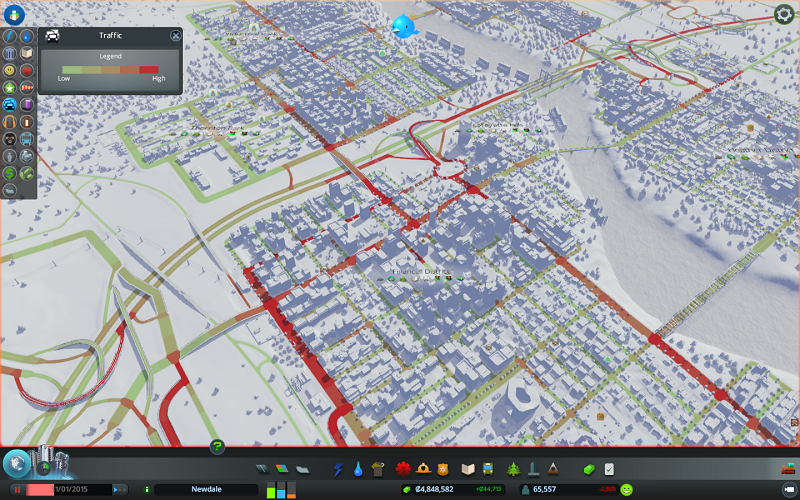
Traffic management is a very important part of the game.
5.Each District Has Its Own Purpose
Learn more about districts with ths guide.
A new and interesting feature in Cities: Skylines is the creation and the management of Districts.
You can mark off an area of your city to assign a specialization to it. If it is an industrial zone, you can make people who work there specialize in a certain type of industry rather than build generic factories.
In other games, usually the policies you decide on apply to the entire city. This is also the case in Cities: Skylines, however you can also assign a unique set of policies to a district. In that case, the district's policy will take precedence over city-wide policies, which may result in a neighborhood with a strikingly different feel from the surrounding area.
This feature allows the player to be really creative while building the city of their dreams. For instance, you may ban smoking in your city, but allow smoking in a specifically designated area, or make the public transportation in your city's center free, which will cause it to generate no income but encourage people to take it, reducing pollution.

An example of District creation.
6. The Usual Zoning System With A Plus
Like in most city builders, you will need to assign zones in your city that will encourage people to build their houses or businesses there.
Cities: Skylines follows the tried-and-trusted system comprised of residential, industrial and commercial zones which you can “brush” over the map to make the corresponding buildings spawn in each zone. Zoning costs nothing, but the buildings must have access to a road and other infrastructures (water, electricity), which are not free.
There is also an interesting addition to the usual zoning trio: office zones. Office zones do not produce goods or generate pollution, but they provide highly skilled citizens with well-paying jobs, which contributes to your city's economy.
You start out with low density zones and unlock high density ones upon reaching certain milestones in your city's development. Density does not only reflect the population per square metre, but also certain tendencies in citizens who live or work there. For example, low density residential areas will attract working adult couples who will start families, while high density residential zones will tend to attract young people – students or migrants who tend to live alone.
Much like the roads, zoning is freeform! Your districts do not need to be rectangular, they can be any shape, which contributes to a very realistic look. Sometimes this will even be required since you'll need to build around rivers and mountains, and there is no terraforming feature in the game as of yet.
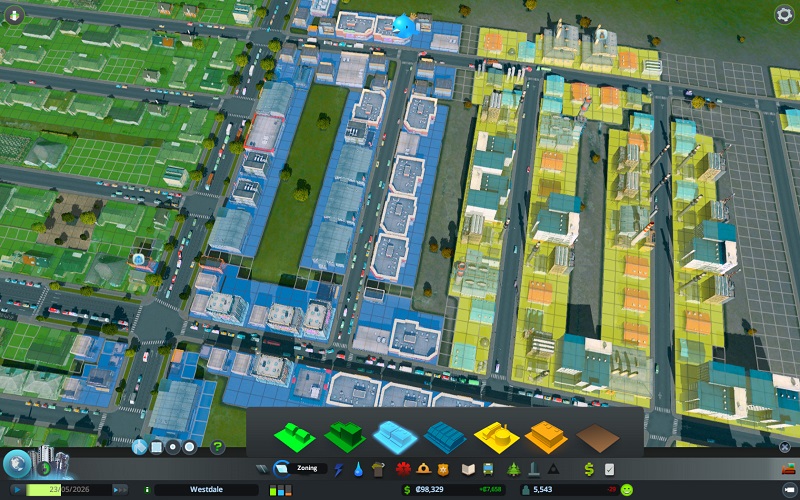
The color scheme is reminiscent of Sim City – green for residential areas, blue for commerces and yellow for industry.
7. A Complex Economy

Agricultural subsidies? In THIS economy?
The economy is quite complex in Cities: Skylines.
There is the usual budget, which you spend on services and facilities. Education, police and health services all need to be funded. The road, water, electricity and waste management infrastructures need to be maintained. All of that costs money.
You can decide to allocate a bigger part of the budget to a specific service. Doing so will increase its efficiency. Similarly, if a sector is operating with excess, you may reduce its budget to avoid unnecessary spendings.
In other city builders, your city's income is rather simplistic and comes from a tax that all residents pay. Cities: Skylines expands this system. In addition to the fact you may assign a specific tax rate to each district, residents, commerces and industries all pay different taxes.
Citizens pay a tax on their income, commerces pay a tax when they sell goods and industries pay taxes on goods they produce. In addition to that, you may tax the various specialized industries in different ways, which may also have a repercussion on your city's economic landscape.
In theory, a city can be self-sufficient; in practice, however, you will need to buy things there is a shortage of and sell your excess production. Even you can't “see” the outside world, only your city, you will still need connections to it. You need to build ports, airports and highways to make sure your city never lacks anything.
8. Some Unusual Things You Have To Manage
In addition to the usual features of the genre that we are familiar with, Cities: Skylines introduces a few surprises. For instance, while managine the public health system is a staple of the genre, you'll find out you also need to manage refuse, and do so in ways that do not harm the environment, and ultimately the health of your citizens.
The residents may also die of old age. In other games, the city's population counter simply dropped to account for deaths. In Cities, your citizens will need to be given a proper burial. Their bodies can be buried at a graveyard, or incinerated at a crematorium. Some religious citizens will refuse to be cremated, forcing you to provide a balance between these two facilities.
The land you're building your city on has natural resources, which you can exploit to develop your city's industry – but this also forces you to plan your city's layout ahead since you need to unlock specific technologies before you can mine ore or extract oil, for instance.
9. Unlock More Land To Expand On
Even more terrain to build on!
In a lot of city builders, there always comes a point when there is simply no more land to build on. At that point, all you can do is micro-manage your city to keep it running and the game has essentially reached its end.
Not in Cities: Skylines. You can purchase more and more parcels of terrain to keep expanding your city as you see fit. Even though maps still aren't unlimited, as expansions are limited, it is still an awesome feeling to know that once your city reaches its current limits, it is still not the end.
To give you an idea of how big the map can get, each tile is 2x2 km in size, and by default there are 9 tiles you can purchase. There are even mods that increase the limit on land tiles if you still feel that it is not enough!
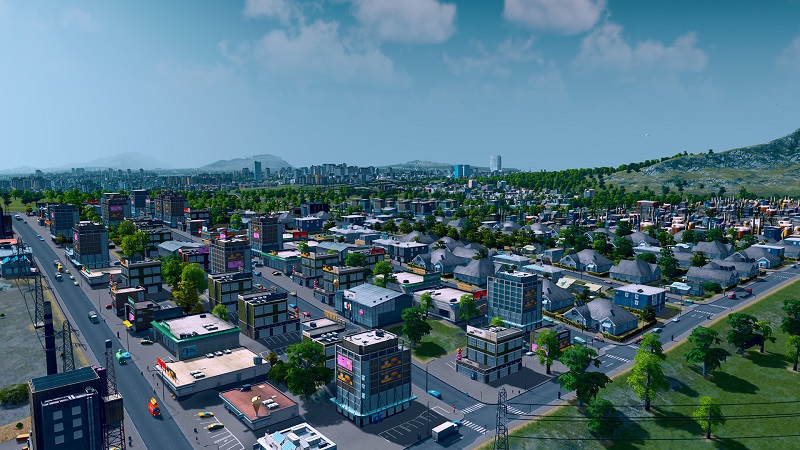
Time to buy more land to build on.
10. There Is Modding Support
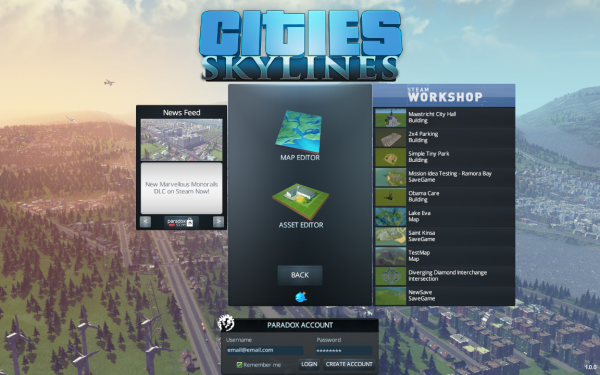
The title provides you with a range of tools for all your modding needs.
Cities: Skylines features map and asset editors as well as mod support.
The modding community has been amazingly productive and you can find a lot of mods in the Steam Workshop or at dedicated modding sites.
You can find new maps (the game only comes with 9 default maps) as well as various quality of life improvement mods, not least of which is the mod that allows you to keep expanding beyond the 9 tiles allocated to you by default.
There are also new assets, buildings, roads and some modders are even trying to rewrite scripts for key aspects of the game, such as terraforming.
If you have built the ultimate megalopolis and hit the limits of available terrain, if your population's happiness is through the roof and you have pretty much created the paradise on Earth and think you have seen everything that Cities: Skylines has to offer, try running a new game with some mods.
What do you think of this game so far? Leave your impressions of the game in the comments below.
Image Gallery
- Log in or register to post comments
- 2426 reads
 Home
Home PC Game Trailers
PC Game Trailers News
News Menu
Menu











![[Top 15] Cities Skylines Best Builds That Look Amazing Cities Skylines Best Builds That Look Amazing](https://www.gamersdecide.com/sites/default/files/styles/308x185-scale-crop--more-top-stories/public/cities-skylines-best-builds-1.jpg)








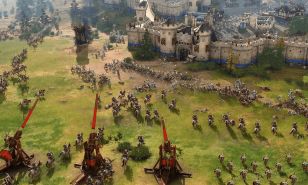





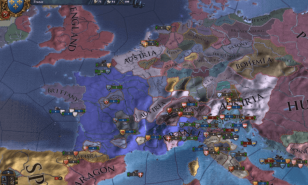








![[Top 15] Games Like Total War (Games Better Than Total War In Their Own Way) Warhammer 3 capture, a clash between chaos warriors and ogres.](https://www.gamersdecide.com/sites/default/files/styles/308x185-scale-crop--more-top-stories/public/games-like-total-war.jpg)

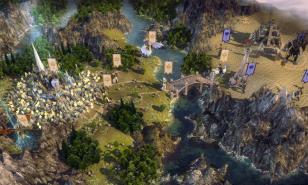



















![[Top 15] Cities Skylines Best Maps (Base Game and DLC) Cities Skylines Best Maps (Base Game and DLC)](https://www.gamersdecide.com/sites/default/files/styles/308x185-scale-crop--more-top-stories/public/cities-skylines-best-maps-1.jpg)


